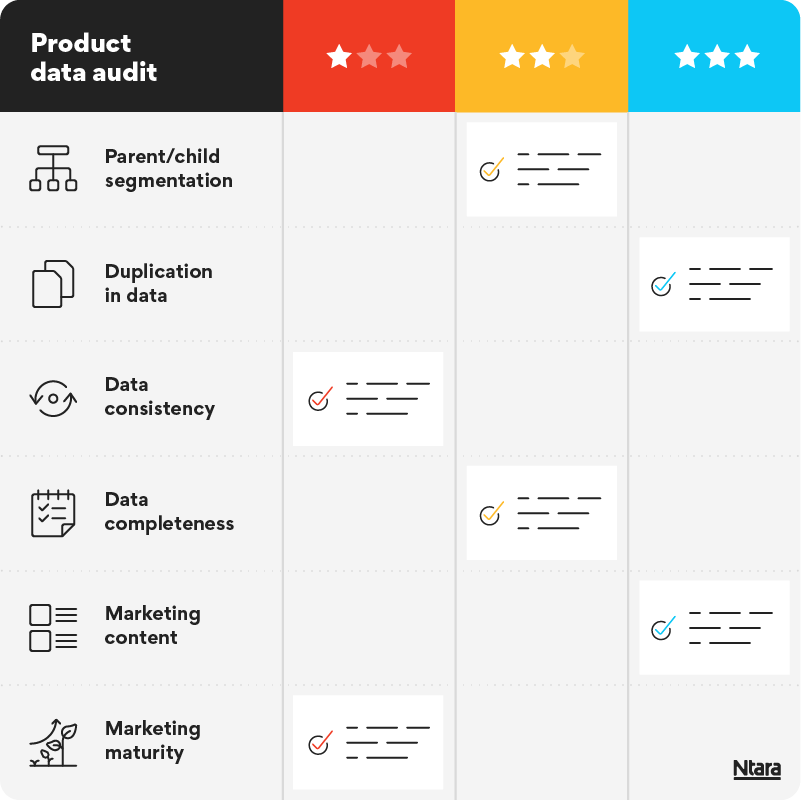
If you think you have a problem with your product data, you probably do. Common symptoms of a product data issues might look like this:
- Broken faceted search on your website
Incomplete or inaccurate data appearing in filtered categories - Automation errors from elsewhere in your product data journey
For example: PLM, DAM, ERP, or downstream partners - Instances of incomplete or “dirty data”
Sent in by internal stakeholders, customers, distributors, or really good friends - Use of custom-built tools and/or Excel to store and update product data
You know human-generated errors are present but you can’t exactly point to where - Documentation of product data issues, but no idea where to start
Which fixes are highest priority? Which fixes be automated?
Why you need a product data audit
Product data takes a long, convoluted journey through most businesses. Many people are involved in the process. The more products you have and channels you send to, the more likely it will have errors.
Product data is the oil of your ecommerce engine. If it is dirty or missing important elements, it can disrupt ecommerce performance.
Before you can add new sales channels or scale ecommerce, you must wrangle your product data. You must know which channels you plan to sell through and what data fields they require, in what format. Your data must be clean, ensuring that your business can produce, manage, and syndicate it.
Most businesses don’t have their product data in order. But the first step in getting there is a product data audit.


What is a product data audit?
A product data audit is an actionable analysis. It identifies the major problems in your data. It helps determine what’s fixable via automation—and what needs help from skilled copywriters or product managers.
For many companies, this may seem daunting or even impossible. You may have tens of thousands of products and hundreds of data attributes for each product. That translates to millions or more individual data points to address.
Ntara’s approach makes this massive task more manageable. We select representative samples of each major data source. Then, we apply a series of proprietary data tools and processes to get an accurate picture of your data. This eliminates the need to examine every individual data field.
How Ntara approaches product
data audits
An Ntara data audit will score your product data performance across six key categories.
- Parent/child segmentation
How have you categorized standard product features (shirt) versus choices (size, color)? - Duplication in data
How much duplicate data exists across your rows, unique IDs, or unique descriptions? - Data consistency
How well are you maintaining data clarity with data elements, data types, and variables? - Data completeness
How many holes do you need to fill across your product dataset? - Marketing content
Do you have product descriptions, benefits, cross-sells, upsells, kits, configurations, etc.? - Marketing maturity
Is your data complete enough to meet downstream channel requirements?
This six-pillar analysis shows what’s causing your biggest product data challenges.

What you get from a product data audit
After the audit, you’ll get a custom optimization plan. It will outline the current state of your data and the level of effort required to fix it.

Composite data score
Compete audit report, showing data analysis by category and detailing overall score

Readiness assessment
Is your data ready for PIM or does it need cleansing first?

Data fixes
Listed in priority, detailing what can be automated and what gets fixed manually

Additional considerations
Suggested data points to capture and where they should come from

Who’s going to fix it
We can help you manage fixes or hand off the plan to your internal team
Learn more about standardizing your product data.
In this article, learn how to reduce your risk through data cleanup and data management.
Get more product data content in your inbox.
Join our email list to receive information from the digital consultant’s perspective.
Ready to discuss your product data audit?
Schedule a meeting with a member of our team to begin the conversation.
